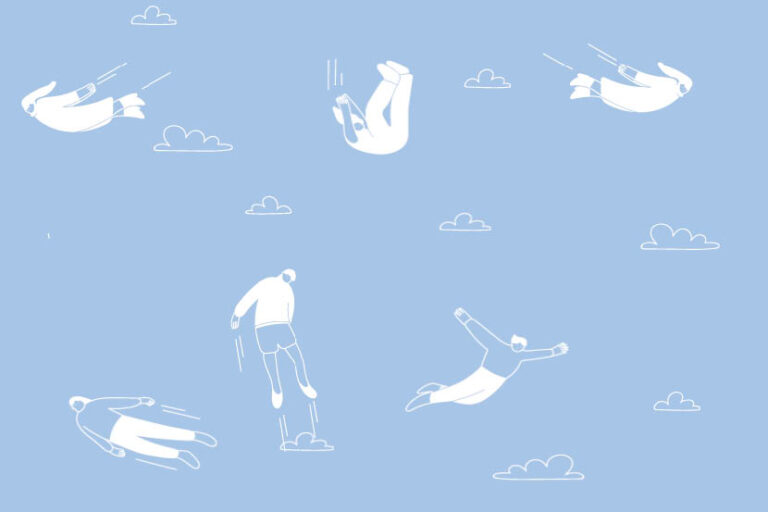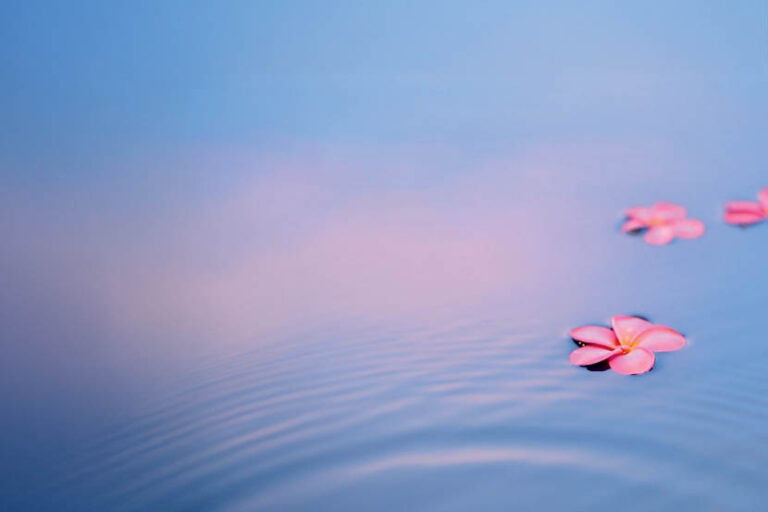
Whether you seek exhilaration, calm, rejuvenation, wonder, or more, wild swimming offers it all
I live in the seasons more since I’ve become a swimmer. I notice when spring arrives, and the riverbanks are transformed with water mint and yellow flag. Summer begins and my local area gets busier. Families queue, rubbing sunscreen on small children, and the smell of 50+ floats in the air. By autumn, everything turns golden. Days get shorter and there’s the opportunity to swim at sunrise without waking too early. Suddenly – quicker every year, it seems – it’s winter and time to start wearing neoprene socks to stop my feet freezing. It often feels that the truest way to experience nature is through swimming, so is it any surprise that so many people now search out this kind of rewilding? I certainly do.
Swimming has been a part of me for as long as I can remember, but I drifted from it on the path to adulthood, only to find it again after my brother’s death. I’d joined a friend for a New Year’s Day swim and the water so anaesthetising. Everything melted away. I was hooked. Since then, I’ve met many people who have similar stories to tell. How they lost swimming and how they came to find it again. For many of us, it’s a hope that we might reach a “beforetime”. Before grief, before heartbreak, before the loss of innocence. When an event in life calls us to return to early memories that involve freedom, nature, and play.
Swimming keeps us in touch with our childhood and also keeps us young. It reduces body pain and inflammation, boosts your immune system, and improves circulation. Evidence suggests that with “cold adaptation” through repeated exposure to cold water, it’s possible to lower blood pressure and cholesterol, inhibit blood clotting, and increase your libido. I’ve long read these facts in an attempt to articulate what exactly it is that swimming does for me, but nothing quite captures it. The closest I can get is that when I swim, I’m returning to myself. But see, that sounds quite silly. So, let’s just say that swimming is good for you. Swimming brings joy.

Float in the driest desert on Earth
September to November | March to May
In every direction a diabolical carpet of parched, fire-red rock melts into a dusty horizon as far as the eye can see. This alien landscape, sculpted and scorched by the wind and unforgiving sun, feels thrillingly biblical. Its unfathomable immensity and lack of civilisation is enough to make you run away – or dig your heels in and exalt the unfamiliar. Knowing that human survival here depends on catching fresh water from fog only heightens the powerful sensation of landing in outer space. And, yes, this is the place where NASA tests life-detecting tech gear for its robotic missions to Mars. Beyond the extreme isolation, there is a piercing beauty to be found in this surreal, majestic landscape. Astonishingly, the great sweep of Chile’s arid Atacama Desert is bejewelled, like delicate drops in the ocean, with a remote cluster of tiny dipping holes cupping sun-spangled, emerald water.
Back to basics
There’s nothing manicured about the seven gem-hued lagoons that form the Lagunas Escondidas de Baltinache. Bar a wooden walkway constructed across rocks to ensure swimmers stick to the footpath and leave no trace, there is zero concession to modernity or comfort. Two lagoons are accessible to swimmers, and their bijou size alone assures instant comradeship with other brave souls foolhardy enough to swim. December to February aside, you might well be alone. Whatever the month, the water is cold: bracingly cool on a burning summer day in January, and so glacial in wintery July that upon full immersion every bone in your body screams “No!” between breathless, shell-shocked gasps for air.
In salt we trust
But then the magic washes over you. Except for the lapping of water and a swimmer’s occasional squeal, the silence is vast and golden. A crust of pearlescent white salt rims the topaz lagoon and a sugar dusting of salt crystals sparkles in the sunlight on the rocky red flats beyond. These lagoons were formed by tectonic shifts millions of years ago and pondering their geological journey from ocean to present-day puddle while bobbing around is mind-blowing stuff – that is, once you’ve mastered the more urgent need to float comfortably on water so salty it rivals the Dead Sea. A sign at the entrance warns not to get salt water in your eyes: a relaxed, on-your-back “happy baby” yoga pose with out-stretched legs is the way to go.
A journey back in time
Floating effortlessly in the salt-crusted pool under a dome of china-blue sky and amid silence so complete you “hear” the birds silently wheeling overhead, you are cocooned in stillness. Already the bone-rattling journey to this barren desert – a desolate dust road along Valle de la Luna (Moon Valley) and the volcanic spine of Cordillera de la Sal (Salt Mountains) – has transported you to an era that existed before humankind meddled with nature. Revel in the extraordinary, exhilarating ride.
Find your joy
- Getting there: You’ll need 4WD wheels to navigate the painfully bumpy unpaved road (the B-241) to the lagoons, 50 kilometres southwest of San Pedro de Atacama. Count on two hours.
- Challenge level: On hot, calm days, when the deep pools are mirror-still, bathing is pleasurable and easy for adults and children alike. Sunscreen isn’t allowed so watch for sunburn. In winter, fierce winds and arctic-cold waters raise the threshold to seriously challenging.
- Further information: Don’t confuse Lagunas Escondidas de Baltinache with the over-touristed Laguna Cejar and its sister lagoons Baltinache and Piedra, 20 kilometres south of San Pedro. Note that the site is shut in rainy or inclement weather. Admission costs 10,000 CLP (around $20 AUD) and includes use of toilets and picnic tables. Bring canisters of water to rinse off with (or depart cloaked in a corrosive white sheen), towel, drinks, snacks, and warm clothing.
‘If there is magic on this planet, it is contained in water’ ~ Loren Eiseley
Other seriously salty swims
Salinas de Pedra de Lume, Cape Verde
White-sand beaches lace the island of Sal in Cape Verde, but it’s the inland pool in the crater of an extinct volcano that lures swimmers seeking a unique experience. Cradling what’s said to be the saltiest water on Earth after the Dead Sea, Salinas de Pedra de Lume is a chessboard of brilliant white salt pans and pink-hued saline water.
Lac Retba, Senegal
Also known as Lac Rose (Pink Lake), this wild lagoon 35 kilometres northeast of Senegalese capital Dakar is occasionally shocking-pink due to harmless microalgae that thrive in its extreme salty depths. While fishermen in wooden canoes harvest salt from the lagoon bed, swimmers float in the syrupy water and emerge encrusted in salt. Rinse off after in a natural spring.
‘Swimming is good for you. Swimming brings you joy’ ~ Freya Bromley

My Swim
I’ve broken ice to swim lakes in the French Alps and star-gazed from volcanic hot springs in Bolivia, but no dip has felt as wild as this desert oasis. It was winter.
The air temperature hovered around zero and a cutting wind made conversation and walking in any vaguely reasonable fashion impossible. Getting into the water was tough. I was terrified the angry current whipped up by the Herculean gale would slam me against the pool’s rocky edge. I summoned that old wild-swimmer chestnut, “you never regret it afterwards”, and levered myself gingerly into the water. Breathe. Surrender. The glacial ice-blue water stung my skin, pierced my core like an electric shock, instantly froze my hands and feet. Yet as my gaze sank to the level of the surrounding sea of crystal-kissed rock, shimmering red in the setting sun, my soul soared. ~ Nicola Williams
 | This is an edited extract from The Joy of Wild Swimming, RRP $39.99. Reproduced with permission from Lonely Planet. Visit www.booktopia.com.au. |



















